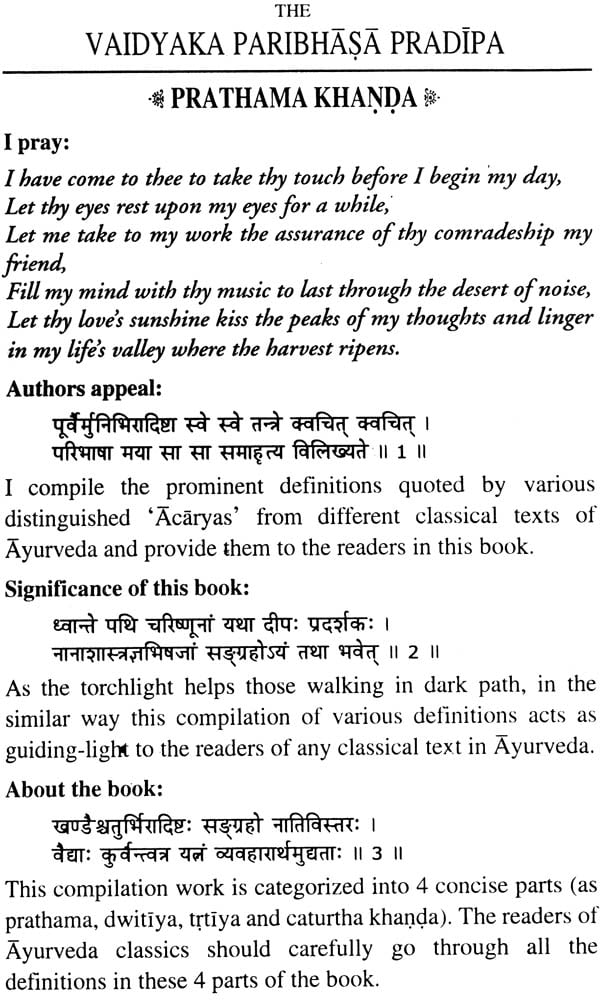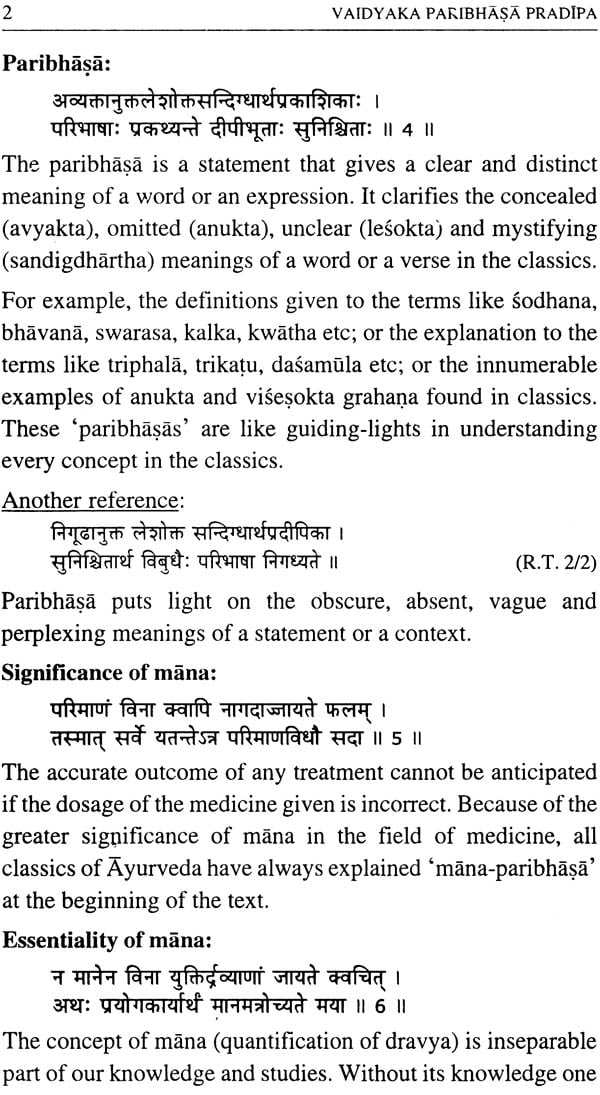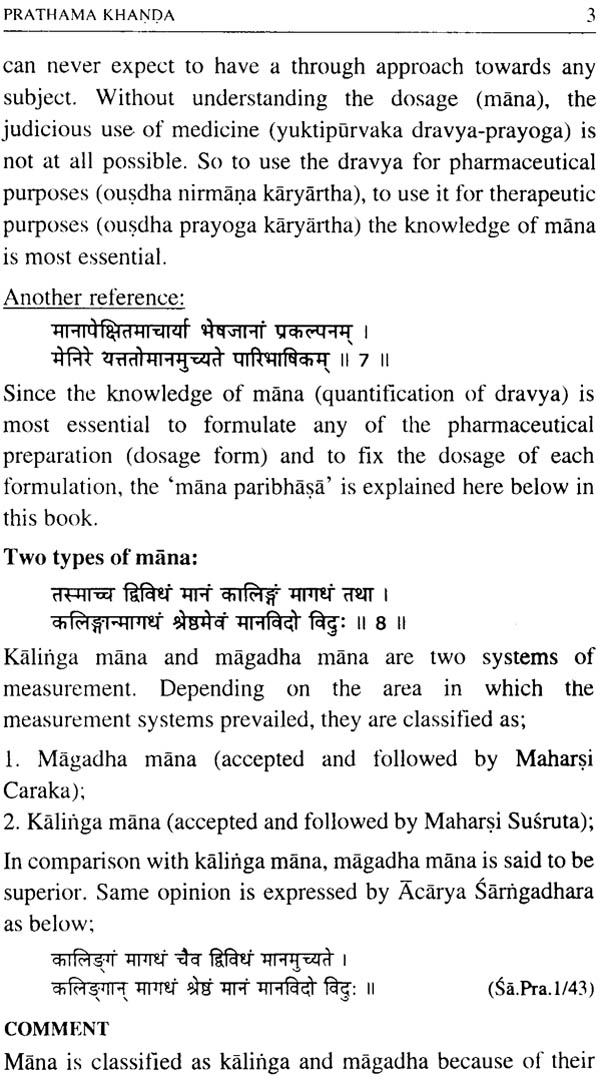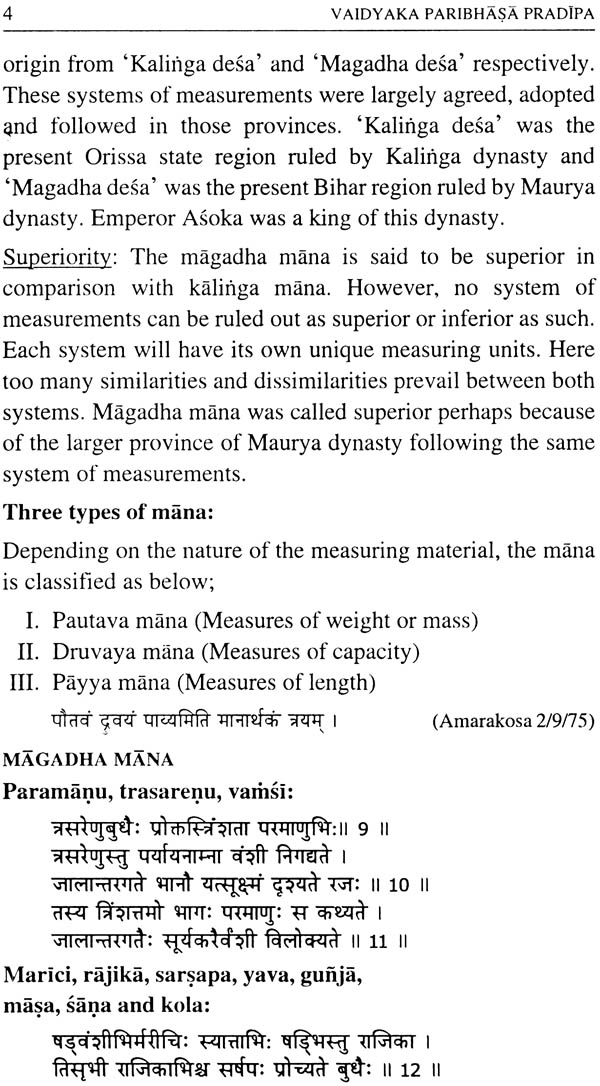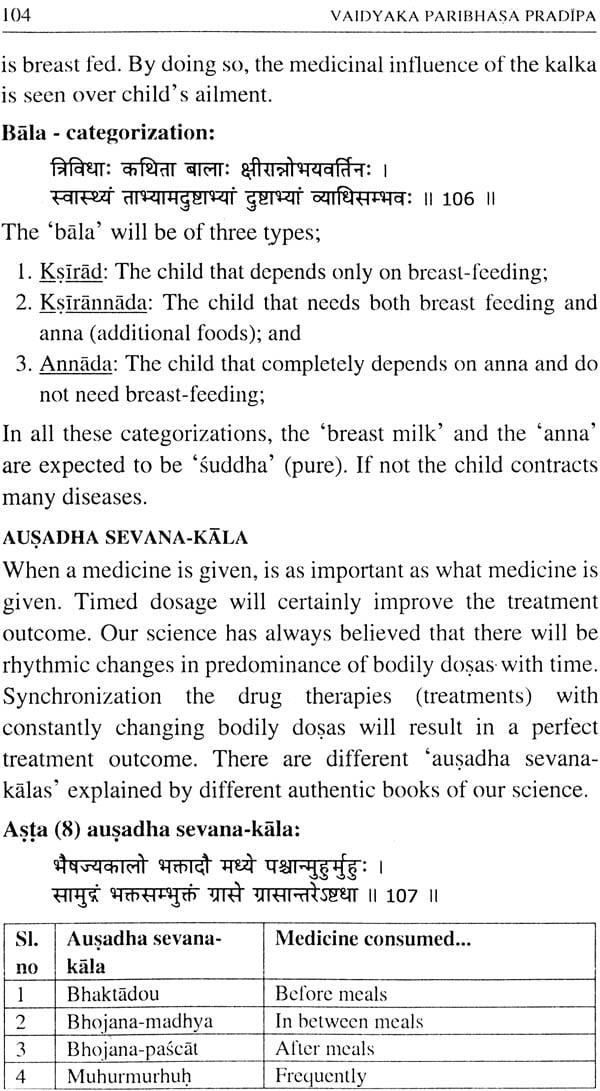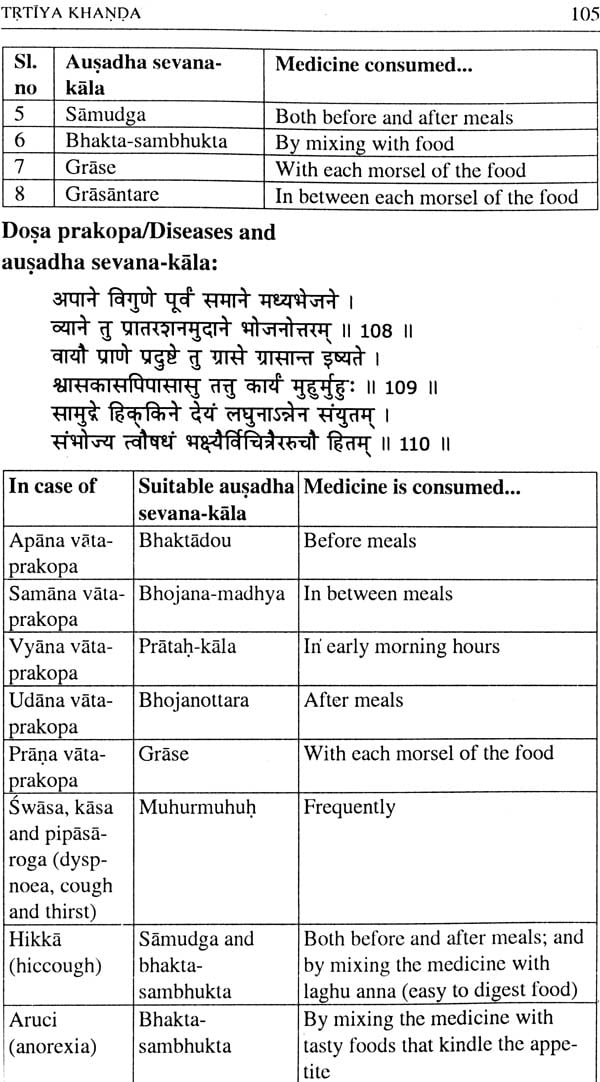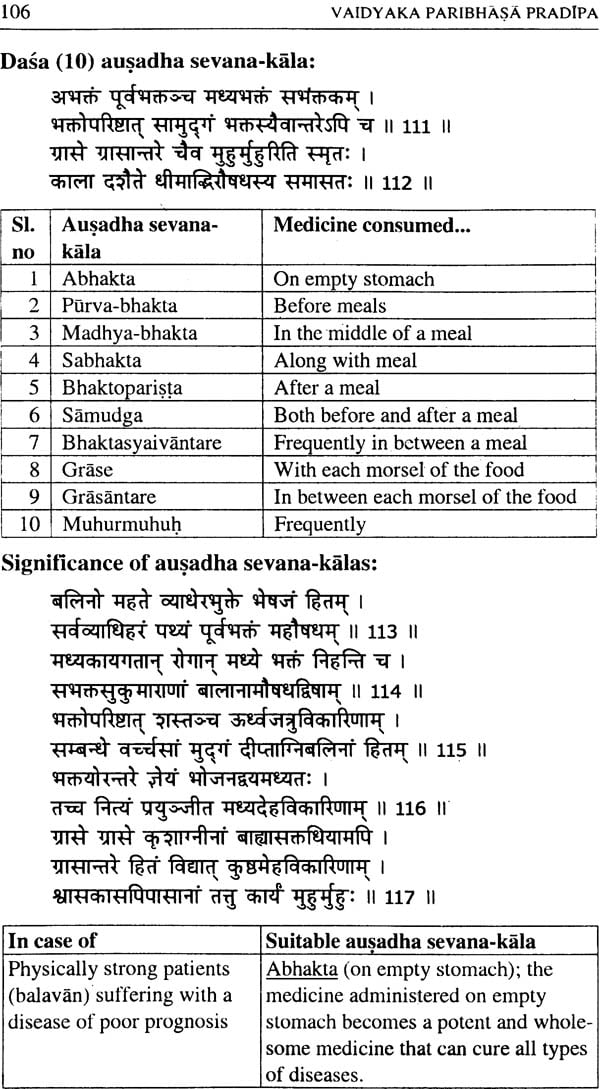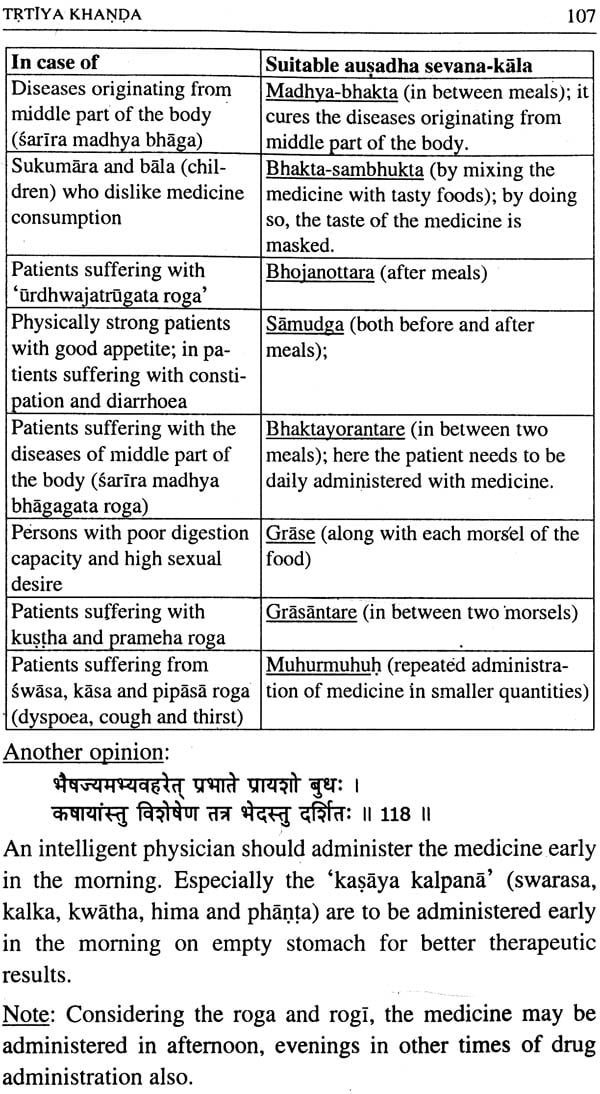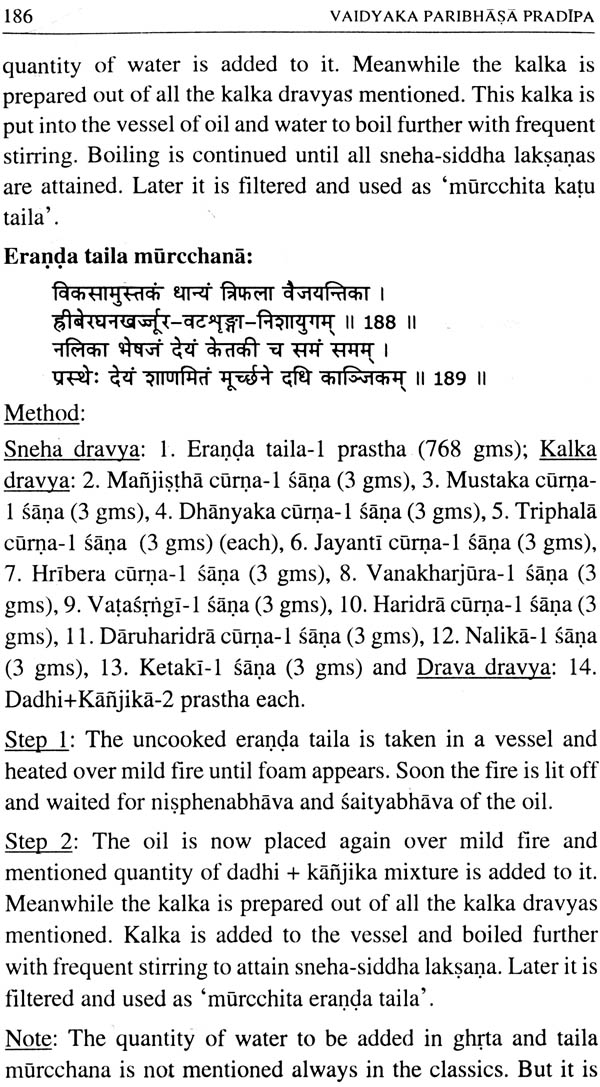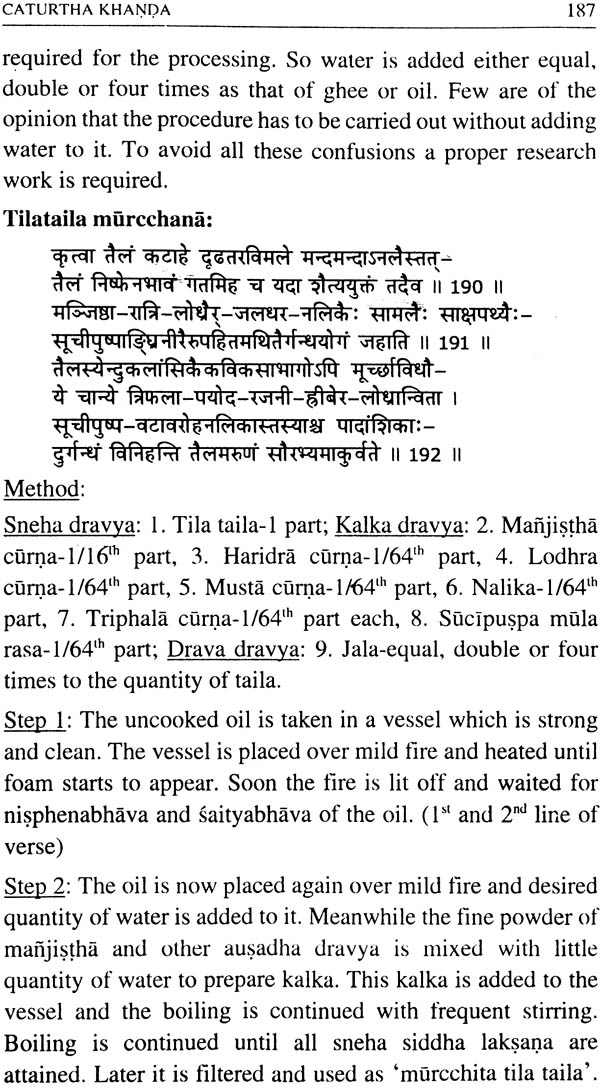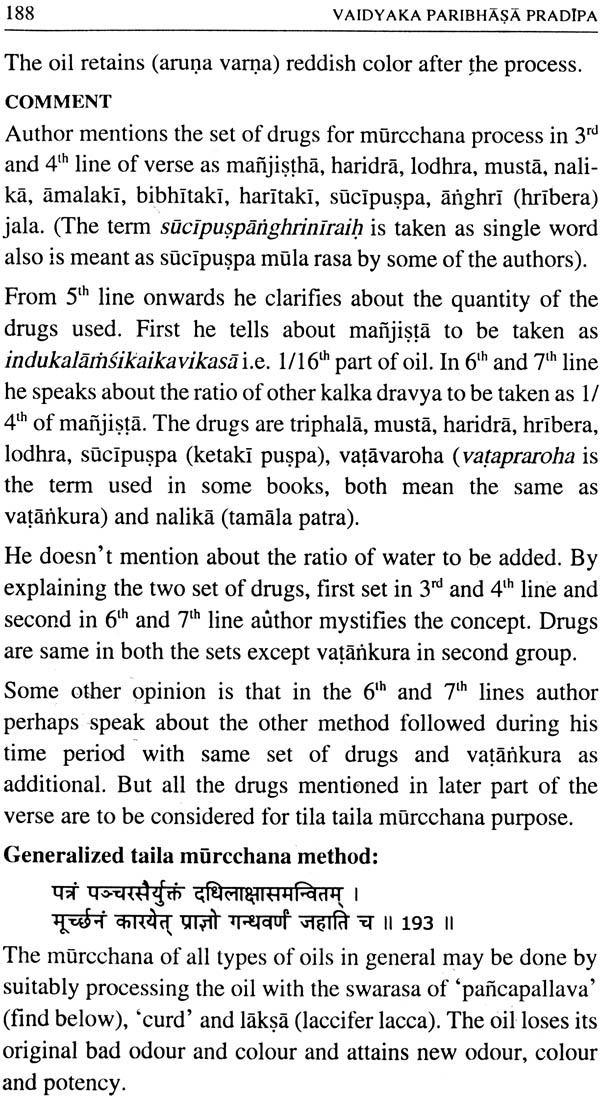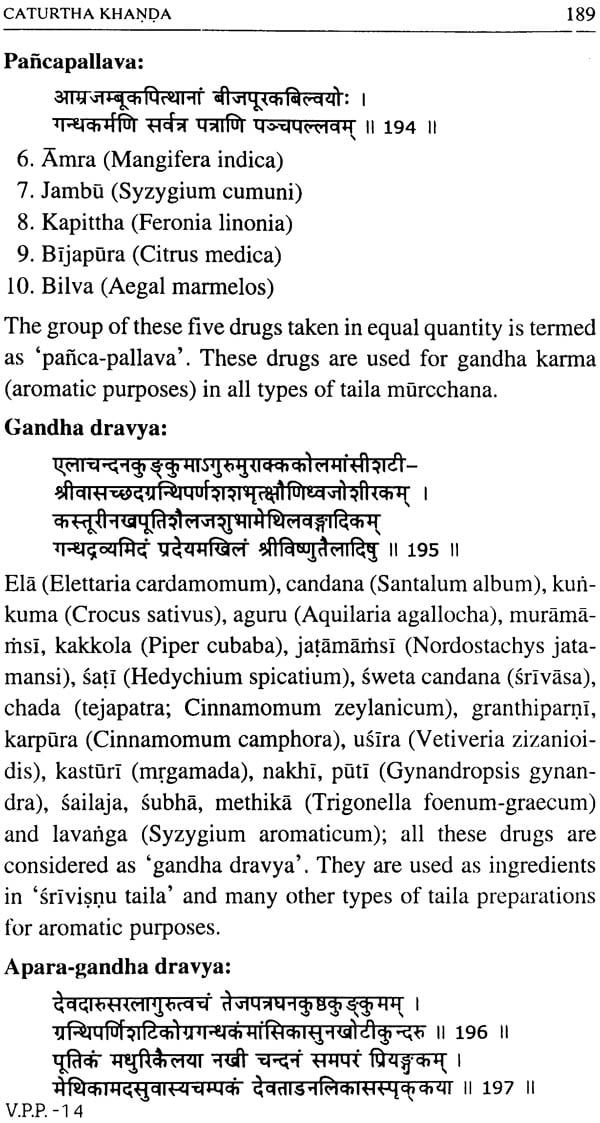
Vaidyaka Paribhasa Pradipa (The Captivating Magic of Classical Ayurvedic Terminologies): A Dictionary of Ayurveda
Book Specification
| Item Code: | NAD397 |
| Author: | Dr. Ravindra Angadi |
| Publisher: | Rashtriya Sanskrit Vidyapeetha, Tirupati |
| Language: | English |
| Edition: | 2013 |
| ISBN: | 9789381484838 |
| Pages: | 220 |
| Cover: | Hardcover |
| Other Details | 8.5 inch X 5.5 inch |
| Weight | 450 gm |
Book Description
Vaidyaka Paribhasha Pradeep is a brilliant compilation of the significant definitions in the field of Ayurveda by ri Govinda Dãsa Sena, the eminent author of the book ‘Bhaiajya RatnävalI’.
The book has four parts as ‘prathama’, ‘dwitIya, ‘qitiya’ and ‘caturtha’ khanda. Prathama khanda has the basic definitions from Ayurveda which become the guiding lights throughout to assess and understand the science in a better way. Deity and titian khanda contain the most crucial definitions of the basic preparations required for the Ayurvedic treatment, explained in a highly structured and organized way. The caturtha khanda is exclusively dedicated to the definitions from ‘paficakarma’. It contains the noteworthy descriptions of all the significant terminologies related with every procedure in ‘pañcakarma’.
For all the terminologies featuring in this book, the commentator has put in his best efforts to furnish the most appropriate and authentic illustration through his TRANSCENDENCE descriptive English commentary.
Dr. Ravindra Angadi works as assistant professor and recognized PG guide in Post Graduate department of Rasaastra and Bhaisajya Kalpana, at S.D.M. College of Ayurveda, Kuthpady, Udupi, Karnataka.
His earlier book named ‘A TEXT BOOK OF BHAISAJYA KALPANA as per CCIM’s new UG & PG Syllabus’ published in the year 2009 by Chaukhamba Surbharati Prakashan Varanasi, is widely appreciated and blessed by seniors in the field and is gladly accepted by the student fraternity of Ayurveda.
The charm of ‘classical terminologies’ used in the different texts of Ayurveda, lies in their superb quality of spontaneity, of universality and of perennial freshness they hold and impart on to the science. The compactness in the definitions of these terminologies with deeper and hidden meanings makes them more appealing to the readers.
To understand the science with proper rationality, one should be good in perceiving the hidden, concealed, partially explained and at times mystifying meanings of these definitions. Many a times we tend to look at the concepts in our science with an orthodox mindset. However, with so much of advancement in the science, we must think beyond out conventional ideas to inculcate newer knowledge into the science.
The term ‘transcendence’ means the same. It is the quality of being able to go beyond normal limits or boundaries. At this juncture I am glad to introduce the ‘transcendence commentary’ to ‘VAIDYAKA PARIBHASA PRADIPA’ a book compiled by Acarya Govinda Däsa Sena.
This work is a humble attempt to bring a handy referral book of definitions, which will be useful to everyone in the field of Ayurveda. The under graduates, the post graduates and’ the students appearing for PG entrance examinations may find this book more beneficial.
With completion of writing this book, I remain humbly grateful to all the individuals who have played a role in making it possible. At the outset I would like to express my humble gratitude to the President of our institution Rajarshi Dr. D. Veerendra Hegde, Vice President Prof. S. Prabhakar, Secretary Prof. Yashovarma and the management for blessing me with an opportunity to serve in their institution, which is the source of inspiration in all my works.
I am extremely obliged to our beloved principal Prof. U. N. Prasad, and for his constant warm hearted support and blessings in all my works. At the same time I am blessed to have the kind support and blessings of Prof. Prasanna N Rao, Principal, SDM College of Ayurveda, Hassan.
My respects are with all the senior staff and colleagues from different departments of our institution for their kind suggestions all through. I respectfully thank head of our department Prof. Prabhakar Renjal and all my colleagues Dr. Sujatha K., Dr. Seema M. B., Dr. Muralidhar Ballal, Dr. R. R. Geethesh, Dr. Ashok Kumar B. N., Dr. Sudheendra Honwad and Dr. Srinidhi Ballal, for their friendly support and valuable contribution in clarifying many controversial points of the subject.
I politely remember Dr. Govinda Sharma, Dr. Basavaraj Ghanti, Dr. Vinay Kadebagilu, Dr. Gazala Hussain, Dr. Reshma, Dr.Parthipan and Dr. Tejasvini; my colleagues from SDM Ayurveda College Hassan, for their friendly support.
My respects will be always with Prof. C. B. Jha, Prof. R. S. Sarashetty, Prof. Asmita Wele, Prof. B. B. Joshi, Prof. P. K. Prajapati, Prof. Vilas Dole, Prof. Yariswamy, Prof. Ashok D. Satpute, Prof. Rajashekhar Pande, Prof. M. C. Patil, Prof. Dinesh Kumar Mishra, Dr. Satyanarayana Bhat, Dr. Anandalakshmi, Dr. Vishi Bansal, Dr. Madhuri Dálvi, Dr. Rajalaxmi, Dr. Sekhar Reddy, Dr. Danappa Goudar, Dr. Jagadeesh Mitti and many other friends of mine from RS and BK departments; with whom I have exchanged my views about the subject at different instances. I thankfully remember all the earlier PG scholars of RS and BK department from our college, who are presently working in different institutions as staff. They have immensely contributed in enriching our knowledge of the science through fruitful debates and discussions. Concurrently I am pleased with all the UG students of our institution since 2003 for the sincerity and dedication they have shown towards the subject I deal.
I am thankful to all the library staff of our college for their help in providing the needed referral stuff for this work.
I remain individually obliged to Mr. N. K. Gupta of Chaukhamba Surbharati Prakashan and his computer crew for the wonderful edition of the book.
My love and respects are with my daughter Bhoomi, my wife, parents, sisters and their families for their unconditional support.
| Authors appeal | 1 |
| Significance of this book | 1 |
| About the book | 1 |
| Paribhasa | 2 |
| Significance of mana | 2 |
| Essentiality of mana | 2 |
| Two types of mana | 3 |
| Three types of mana | 4 |
| Magadha mana | 4 |
| Chart for magadha mana | 5 |
| The shorter version of table (Magadha mana) | 7 |
| Kudava patra | 7 |
| Kalinga mana | 7 |
| Chart for kalinga mana | 9 |
| The shorter version of table (Kalinga mana) | 10 |
| Comparison between Caraka, Susruta and Sarugadharokta poutava mana | 11 |
| Rasarnvokta pautava mana chart | 12 |
| Rasa Vagbhatokta pautava mana chart | 12 |
| Bharatiya pautava mana | 13 |
| Metric system of measurements | 13 |
| Imperial system of measurements | 13 |
| Druvaya mana or tarala mana (Measures of capacity) | 14 |
| Payya mana (Measures of length) | 15 |
| Kala mana (Measures of time) | 15 |
| Dravardrasuska dravya mana | 16 |
| Ausadha namakarana (Naming of preparations) | 16 |
| Dviguna mana ganana (The rule of duplication) | 17 |
| Reason for the rule of duplication | 17 |
| Exception for the rule of duplication | 17 |
| Dry and wet drug collection | 18 |
| Saviryata avadhi of sneha kalpana | 19 |
| Saviryatavadhi | 19 |
| Saviryatavadhi (shelf life) and dosage of different dosage forms | 20 |
| Deletion or replacement of drugs in a compound preparation | 21 |
| Place of drug collection | 21 |
| Land of mahabhuta predominance and drug collection | 23 |
| Places from where drugs should not be collected | 24 |
| Consideration of specific plant parts | 24 |
| Collection of specific plant parts (Prayojya anga) | 25 |
| Rule for collection of specified plant parts | 26 |
| Careful administration of medicines | 26 |
| Different sources of drug information | 26 |
| Time of drug collection | 27 |
| Specific seasons for specific plant part collection | 27 |
| Anukta-visesokta grahana | 28 |
| Collection of pranija dravya | 30 |
| Abhava/pratinidhi dravya grahana | 31 |
| Liberty to substitute the unavailable drugs | 36 |
| Substituting the unavailable drugs | 37 |
| Replacing the unavailable drugs | 37 |
| Apradhana and pradhana dravya | 37 |
| Deletion or replacement of drugs in a compound preparation | 37 |
| Some of the other significance definitions | 38 |
| Dlpana | 38 |
| Pacana | 38 |
| Samsamana | 38 |
| Anulomana | 38 |
| Sramsana | 39 |
| Bhedana | 39 |
| Recana | 39 |
| Vamana | 39 |
| Samsodhana | 39 |
| Chedana | 40 |
| Lekhana | 40 |
| Grahi | 40 |
| Sthambhana | 40 |
| Rasayana | 41 |
| Vajikarana | 41 |
| Sukrala | 41 |
| Sukra pravartaka | 41 |
| Sukra sthambhaka | 41 |
| Suksma | 42 |
| Vyavayi | 42 |
| Vikasi | 42 |
| Madakari | 43 |
| Visa | 43 |
| Pramathi | 43 |
| Abhisyandi | 43 |
| | |
| Pancavidha kasaya kalpana | 44 |
| Sadvidha kasaya kalpana | 45 |
| Saptavidha kasaya kalpana | 45 |
| Pancavidha kasaya kalpana - general idea | 45 |
| Swarasa kalpana | 46 |
| Swarasa from wet drugs | 46 |
| Swarasa from dry drugs | 46 |
| Swarasa from very hard drugs | 47 |
| Swarasa matra | 47 |
| Putapaka swarasa | 47 |
| Putapaka swarasa method | 47 |
| Kalka kalpana | 48 |
| Kalka - definition | 48 |
| Kalka praksepaka dravya and their quantity | 49 |
| Curna kalpana | 49 |
| Kwatha kalpana | 50 |
| Kwatha - definition | 50 |
| Kwatha - dosage | 50 |
| Hima kalpana | 51 |
| Stta-kasaya (Hima) | 51 |
| Tandulodaka | 51 |
| Phanta kalpana | 52 |
| Sita and phanta as per Viswamitra | 52 |
| Usnodaka | 52 |
| Rasakriya | 52 |
| Rasakriya/Phanita/Kakavi | 54 |
| Vati/Vataka/Gutika/Modaka/Pindi/Guda/Varti | 54 |
| Posology | 55 |
| Factors affecting dose selection | 56 |
| Calculation of child and infant dose | 57 |
| Dose fixation - a simile | 58 |
| Dosage of sneha and kwatha kalpana | 59 |
| Dosage of guda and khanda kalpana | 59 |
| Dosage of modaka, vataka and avaleha | 59 |
| Dosage of guggulu | 60 |
| Dosage of different bhasmas | 60 |
| Kwatha preparation depending on the quantity of the drugs | 61 |
| Rationality | 62 |
| Kwatha preparation depending on the nature of the drugs | 63 |
| Pacana kwatha - water and drug ratio | 64 |
| Kwatha preparation for yavagu, yusa, rasaka etc | 64 |
| K watha preparation for pana, peya etc | 64 |
| Yavagu - rice quantity | 65 |
| Anna kalpana - water ratio | 65 |
| Manda, peya, yavagu and vilepi | 65 |
| Yavagu and krsara | 66 |
| Vilepi | 66 |
| Peya and yusa | 66 |
| Manda | 67 |
| Mamsa rasa | 67 |
| Laksa rasa | 68 |
| Praksepa - general view | 68 |
| Ausadha - praksepa sevana vidhi | 69 |
| Ausadha and praksepa | 69 |
| Praksepa and their ratio | 70 |
| Kwatha - praksepaka dravya | 70 |
| Ksirapaka | 71 |
| Ksira-mastu-aranala paka-vidhi | 72 |
| | |
| Kwatha preparation for sneha kalpana | 73 |
| Ratio of millk in sneha preparation | 73 |
| Kwatha-sneha-kalka In sneha preparation | 73 |
| Five or more than five drava-dravya in sneha preparation | 74 |
| One to four drava dravya in sneha preparation | 74 |
| Ratio of kwatha in sneha preparation | 74 |
| Anukta mana | 74 |
| Puspa kalka quantity | 75 |
| Quantity of kalka-dravya in relation with drava-dravya | 75 |
| Addition of water as drava-dravya | 75 |
| Only milk as drava-dravya | 75 |
| Sneha-paka with no kalka-dravya | 76 |
| Sneha-paka anukta mana | 76 |
| Sneha-dravya anukta mana | 76 |
| Overlooking the sneha ratio | 76 |
| Kwatha - anukta mana | 76 |
| Anukta-visesokta grahana | 77 |
| Kwatha preparation in larger preparations | 77 |
| Sneha kalpana - visesokta grahana | 77 |
| Deletion and addition of drugs from a dravya-gana | 78 |
| Sneha kalpana - definition | 79 |
| Kwatha preparation in sneha kalpana | 79 |
| Kwatha preparation depending on drug's nature | 79 |
| Kwatha preparation depending on drug's quantity | 80 |
| Rationality | 80 |
| Time duration to cook sneha preparations | 81 |
| Time duration to cook sneha and some other preparations | 81 |
| To be processed in single day | 82 |
| Specific rules for sneha preparation | 82 |
| Different drava-dravya and ratio of sneha kalka | 82 |
| Different drava-dravya and ratio of sneha kalka | 82 |
| Number of drava-dravya and their ratio | 82 |
| Sneha preparation when only medicinal drugs are mentioned | 83 |
| Sneha preparation when only kwatha dravya are mentioned | 83 |
| Sneha preparation without sneha-kalka | 83 |
| Puspa kalka in sneha preparation and its ratio | 83 |
| Sneha-siddha laksana | 84 |
| Phenodgama and phena-santi | 85 |
| Sneha paka with ksara jala | 85 |
| Types of sneha paka | 86 |
| Therapeutic utility of different sneha paka | 87 |
| Sneha paka - therapeutic significance | 87 |
| Gudapaka laksana | 88 |
| Guggulupaka laksana | 88 |
| Guggulu kalpana - dosage | 88 |
| Triphala kwatha for loha-sodhana | 89 |
| Triphala kwatha for loha-marana | 89 |
| Triphala bhanupaka kwatha for loha sodhana-marana | 90 |
| Triphala sthalipaka kwatha for loha sodhana-marana | 90 |
| Loha putapaka - quantity of the drugs required | 90 |
| Liquids for loha sodhana-marana | 91 |
| Triphala vyognipaka kwatha for loha sodhana-marana | 91 |
| Kwatha preparation and the drug hardness | 91 |
| Loha-marana - triphala kwatha | 92 |
| Lohapaka laksana | 93 |
| Mrdu and khara lohapaka | 94 |
| Trividha lohapaka | 94 |
| Mrdupaka laksana | 94 |
| Kharapaka laksana | 94 |
| Mrdu, khara and madhyama lohapaka | 95 |
| Bhavana - paribhasa | 95 |
| Bhavana vidhi | 95 |
| Bhavana dravya for bhavana | 96 |
| Ksarodaka | 96 |
| In case of repeated drug in a preparation | 96 |
| Paka and addition of praksepa dravya | 97 |
| Curna and modaka - addition of guda | 97 |
| No duplication of the drug quantity | 97 |
| Anupana - significance | 97 |
| Anupana - benefits | 98 |
| Anupana - selection | 99 |
| Usna-sitodaka anupana | 99 |
| Anupana matra | 101 |
| Anupana as per Patanjali | 101 |
| Suitable adjuvant | 102 |
| Paediatric dosage | 102 |
| Bala - categorization | 104 |
| Ausadha sevana-kala | 104 |
| Asta (8) ausadha sevana-kala | 104 |
| Dosa prakopa/Diseases and ausadha sevana-kala | 105 |
| Dasa (10) ausadha sevana-kala | 106 |
| Significance of ausadha sevana-kalas | 106 |
| Panca (5) ausadha sevana-kala | 108 |
| Chronotherapeutics | 110 |
| Cikitsa kriya-vyavastha | 111 |
| Cikitsa-as per Caraka | 111 |
| Opting for suitable treatment methods | 111 |
| Switching over the treatment methods | 112 |
| Kriya-sankarya | 112 |
| Disease and the season of eruption | 112 |
| Caturamla and pancamla | 113 |
| Pancalavana | 113 |
| Astamutra | 114 |
| Sneha catustaya | 114 |
| Asta-ksira | 115 |
| Tri-sugandhi/Trijata/Caturjata | 115 |
| Sarvagandha | 115 |
| Maha triphala/Swalpa triphala | 116 |
| Maha/mahati triphala | 116 |
| Swalpa triphala | 116 |
| Tryusana | 116 |
| Trimada | 117 |
| Pancaksiri vrksa | 117 |
| Panca pallava | 117 |
| Pancakola/Sadusana | 118 |
| Brhat pancamula | 118 |
| Laghu pancamula | 119 |
| Dasamula | 119 |
| Trna pancamula | 119 |
| Vallipancamula | 119 |
| Kantaka pancamula | 120 |
| Asta varga (Jivaniyastaka) | 120 |
| Jivaniya gana | 120 |
| Sweta marica | 121 |
| Jyesthambu/Sukhodaka | 121 |
| Gudambu | 121 |
| Vesavara | 122 |
| Amla-mulaka (Sour-radish) | 122 |
| Dhadhi - kurcika/Takra kurcika | 122 |
| Sukta | 123 |
| Sidhu/Asava/Maireya | 123 |
| Aranala | 123 |
| Amla-vataka | 123 |
| Krsara or trisara | 124 |
| Swalpa cukra | 124 |
| Asava and arista-difference | 125 |
| Sidhu (Pakwa rasa/sita rasa) | 125 |
| Sura and its layers | 125 |
| Varuni | 125 |
| Guda-sukta | 126 |
| Iksu sukta/Mrdvika sukta | 126 |
| Tusambu/Souvira | 126 |
| Tusodaka | 127 |
| Kanji | 127 |
| Sindaki | 128 |
| Madhu-sukta | 129 |
| Khada- yusa/Kambalika | 129 |
| Tarpana | 130 |
| Mantha | 130 |
| Usndaka | 130 |
| | |
| Pancakarma-significance of samsodhana | 132 |
| Sodhana - 5 types | 132 |
| Pancakarma and consideration of age | 132 |
| Vamana cikitsa - method | 133 |
| Sodhana therapy - Caraka's opinion | 133 |
| Sodhana therapy - unsuitable seasons | 134 |
| Sodhana therapy - suitable season | 134 |
| Samyak vamita laksana | 134 |
| Vamana - benefits | 135 |
| Asamyak vamita dosa | 135 |
| Ativamita - dosa | 135 |
| Vamana - considerable factors | 135 |
| Vamana kwatha matra | 136 |
| Vamanausadha- matra | 136 |
| Vamana-virecana and the use of warm honey | 136 |
| Avamya (Persons unfit for vamana) | 137 |
| Vamana in unfit patients | 138 |
| Vamana-yogya gulma rogi | 138 |
| Vamana-virecana kala and niyama | 138 |
| Vamya (Persons fit for vamana) | 139 |
| A vamya (Persons unfit for vamana) | 139 |
| Vamana in avamya patients | 140 |
| Vamana kwatha matra | 140 |
| Dose of other vamana dravya | 140 |
| Vamana vega | 140 |
| Yamana dravya and dosa | 141 |
| Virecana cikitsa | 141 |
| Virecana - opinion of Acarya Sarngadhara | 141 |
| Virecana guna - as per Susruta | 141 |
| Avantasya virecana nisedha | 142 |
| Avantasya virecana vidhi | 142 |
| Virecana - suitable kala | 142 |
| Avirecya (Persons unfit for virecana) | 143 |
| Virecya (Persons fit for virecana) | 143 |
| Kostha assessment | 143 |
| Virecana matra | 144 |
| Virecana ausadha matra | 144 |
| Kostha - opinion of Acarya Ananda Sena | 144 |
| Virecana ausaha matra - as per Acarya Ananda Sena | 144 |
| Four types of suddhi | 145 |
| Kostha suddhi | 145 |
| Prastha mana in vamana-virecana | 145 |
| Vamana/virecana to be continued until | 146 |
| Counting the number of urges in vamana and virecana | 146 |
| Samyak virecana guna | 146 |
| Asamyak virecana dosa | 146 |
| Ati-virecana dosa | 147 |
| Avirecya (Persons unfit for virecana) | 147 |
| Virecana in avirecya | 148 |
| Nasya cikitsa | 148 |
| Nasya - types | 148 |
| Nasya - definition | 148 |
| Times of nasya administration | 148 |
| Pratimarsa nasya | 149 |
| A vapidana nasya | 149 |
| Sneha nasya | 149 |
| Other two types of nasya | 150 |
| Avapida nasya | 150 |
| Pradhamana nasya | 150 |
| Virecana nasya is used in | 150 |
| Snehana nasya yogya | 151 |
| Avapidana nasya yogya | 151 |
| Pradhamana nasya prayoga | 151 |
| Nasya matra | 151 |
| Nasya yogya | 152 |
| Nasya-ayogya | 152 |
| Anuvasana basti | 153 |
| Basti: a complete and superior treatment | 153 |
| Anuvasana basti | 153 |
| Bastinetra | 154 |
| Bastinetra and its length | 154 |
| Bastinetra and its shape | 154 |
| Basti putaka and basti yantra | 155 |
| Vrana basti netra | 156 |
| Basti netra and its length | 157 |
| Basti netra and its shape | 157 |
| Grahya basti-putaka | 158 |
| Niruha basti | 158 |
| Basti - sequence of explanation | 158 |
| Matra basti | 159 |
| Anuvasya (Persons fit for anuvasana basti) | 159 |
| Nanuvasya/nasthapya (Persons unfit for anuvasana/asthapana basti) | 159 |
| Basti cikitsa - benefits | 159 |
| Sneha basti - time of administration | 160 |
| Anuvasana basti and snigdha bhojana | 160 |
| Basti - hina and atiyoga | 160 |
| Anuvasana basti matra | 161 |
| Niruha basti matra | 161 |
| Anuvasana basti matra | 161 |
| Anuvasana basti pratyagarnana kala | 162 |
| Excessive administration of basti | 162 |
| Ananuvasya (Persons unfit for anuvasana basti) | 163 |
| Anasthapya (Persons unfit for asthapana basti) | 163 |
| Niruha basti | 164 |
| Niruha basti-kala | 164 |
| Niruha and asthapana - definitions of Susruta | 165 |
| Sodhana - sequence and period of administration | 165 |
| Niruha basti-dravya and their ratio | 165 |
| Niruha basti - opinion of Acarya Samgadhara | 166 |
| Asthapana - a synonym of niruha | 166 |
| Niruha basti matra | 167 |
| Anasthapya (Persons unfit for asthapana basti) | 167 |
| Asthapya (Persons fit for asthapana basti) | 167 |
| Niruha basti-kala | 168 |
| Niruha basti-vidhi | 168 |
| Niruha basti pratyagamana kala | 169 |
| Niruha basti dravya - the properties | 169 |
| Niruha basti dravya - an emulsion | 169 |
| Niruha basti dana vidhi | 170 |
| Matrakala | 170 |
| Niruha basti dana | 171 |
| Niruha basti sankhya | 171 |
| Su-nirudha basti laksanas | 171 |
| Samyak nirudha laksanas | 171 |
| Asamyak nirudha laksanas | 172 |
| Ayoga and atiyoga of niruha basti | 172 |
| Uttara basti | 172 |
| Uttara basti-matra | 173 |
| Uttara basti-dana vidhi in male | 173 |
| Uttara basti-dana vidhi in female | 173 |
| Uttara basti in children | 174 |
| Uuara basti kala in female | 174 |
| Uttara bastidana vidhi in women | 175 |
| Bastidaha - measures | 175 |
| Uttara basti - benefits | 176 |
| Uttara basti - laksanas | 176 |
| Phalavarti | 176 |
| Basti dravya-matra - as per Ananda Sena | 176 |
| Dhumapana vidhi | 177 |
| Dhurnapana - benefits | 177 |
| Dhumapana - complications | 178 |
| Dhumapana bheda | 178 |
| Mukha-nasagata dhumapana | 179 |
| Dhumapana - contraindications | 179 |
| Kavala-gandusa dharana | 179 |
| Kavala-gandusa - types | 179 |
| Difference between kavala and gandusa | 180 |
| Kavala-gandusa matra | 180 |
| Kavala-gandusa kala | 180 |
| Kavala-gandusa medicine | 181 |
| Kavala-gandusa hina/ati yoga | 181 |
| Gandusa suddhi laksana | 181 |
| Kavala-gandusa dosage | 182 |
| Raktamoksana | 182 |
| Ati-raktamoksana dosa | 182 |
| Visuddha rakta purusa laksana | 182 |
| Raktamoksana - sthana and vaya | 182 |
| Raktamoksana contraindications | 183 |
| Raktamoksana - a rule | 183 |
| Sneha murcchana | 183 |
| Ghrta murcchana | 184 |
| Sarsapa taila (katu taila) murcchana | 185 |
| Eranda taila rnurcchana | 186 |
| Tilataila murcchana | 187 |
| Generalized taila murcchana method | 188 |
| Pancapallava | 189 |
| Gandha dravya | 189 |
| Apara-gandha dravya | 189 |
| Kakkola - in tailapaka | 190 |
